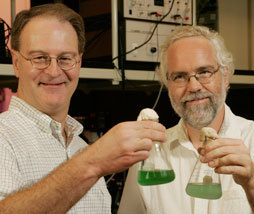Jan 16 2008
If we wanted to create the ideal environmentally friendly energy source, it would be a fuel that is easy and economical to produce, and one that does not pollute the air when burned. That is exactly what researchers at ASU intend to develop in a new program that uses bacteria and sunlight to generate hydrogen, a clean fuel that produces no greenhouse gases.

The project, one of the first to be funded by the ASU President's Intellectual Fusion Investment Fund, is supported by two recent gifts totaling $22 million, and is used to make seed investments in research areas that push the boundaries of traditional academic disciplines.
Funding for the biohydrogen project is being administered through the Global Institute of Sustainability, which with ASU's School of Sustainability has the goals of researching new, environmentally friendly technologies and educating students on sustainability.
ASU's biohydrogen project aims to harness the energy in sunlight using microbial photosynthesis to produce hydrogen. A second part of this project is to convert waste materials from the initial process to produce even more hydrogen.
"Hydrogen is the purest fuel you can think of," says microbiologist Willem "Wim" Vermaas, a professor in ASU's School of Life Sciences and the lead investigator on the project. "It generates energy without releasing CO2 into the atmosphere. It is the ultimate clean energy technology because you are splitting water to make the hydrogen. If you burn the hydrogen, you get water back. In essence, with our process you are converting solar energy into a clean fuel."
"Of course," he adds, "there are many challenges to making this process work efficiently."
Splitting water into its chemical constituents of hydrogen and oxygen can be done through other methods, such as electrolysis. ASU's process is more elegant and does not require any energy other than sunlight. What makes the process work is finely tuned cyanobacteria to carry out the reaction.
Vermaas, a member of ASU's Center for Bioenergy and Photosynthesis, says that researchers have used a cyanobacterial system to generate a small amount of hydrogen using only solar energy. To optimize the system, the microorganism must be retooled to put most of the energy it gathers from sunlight into compounds useful for biohydrogen production.
The ASU researchers, who have years of experience working in this field, are using a cyanobacterium with a known genome and have developed it into a model organism for genetic and metabolic engineering studies. Using its natural photosynthesis machinery, "we are now starting to direct more of the photosynthetic activity into biofuel production, yielding organisms that convert substantially more of the harvested energy into biofuels," Vermaas says.
One of the main challenges for the researchers is finding an enzyme for hydrogen production, called hydrogenase, which can operate in the presence of oxygen. Hydrogenase enzymes are a key component to hydrogen production through the photosynthesis process. However, they are very sensitive to oxygen, a natural by-product of the splitting of water (H2O).
"If you make photosynthetic hydrogen you also make oxygen, and you have a problem because oxygen inactivates the very enzyme that you want to have working," Vermaas says.
One part of the project, headed up by Ferran Garcia-Pichel in the School of Life Sciences, is to find heartier forms of hydrogenase. Garcia-Pichel will be looking at systems that occur in nature.
"Preliminary data suggest that in a variety of natural habitats cyanobacteria can produce hydrogen, which means that unless there is some way the cells exclude oxygen from the process, their hydrogenase enzyme must be oxygen-tolerant," Vermaas says.
"Boosting the oxygen tolerance of the hydrogenase is really a key to the overall system," he adds. With a robust hydrogenase enzyme, the next step is to incorporate their genes into the model cyanobacterial system. But the way they are incorporated and how the oxygen-tolerant hydrogenase is aligned with other enzymes in the cyanobacteria are critical to getting the system to work efficiently.
"We need to be able to effectively connect the hydrogenase to the photosynthetic reaction center complexes of the cyanobacteria. We can do that through metabolic engineering."
Each cyanobacterial cell is about 1.5 micrometers in size, much smaller than what can be seen individually by the human eye. Bacteria's evolutionary drive is to multiply, and in that process electrons and protons are used for the generation of energy and as building blocks for growth of the organism. In the modified cyanobacterial system, Vermaas wants to divert electrons from their normal pathways and push them into new pathways that result in hydrogen production.
"That can be done by more directly linking hydrogenase to where electrons come out of the photosynthetic pathway," he says. "So we are essentially hijacking the electrons to go to the hydrogenase where they, together with protons, form hydrogen."
The third part of the project is to create a microbial fuel cell technology that uses the leftover cyanobacterial biomass generated in the hydrogen production process as the energy source for additional hydrogen production. Bruce Rittmann, director of the Environmental Biotechnology Center at the Biodesign Institute at ASU, is leading the effort in this area.
The researchers will develop the scientific and technological basis for microbial fuel cells that oxidize organic materials in biomass at their anodes, while generating hydrogen gas at their cathode. This work is expected to not only capture energy from cyanobacterial biomass, but it will lay the scientific groundwork for microbial conversion of energy from all kinds of biomass, including human and animal wastes, agricultural crops and residues, and ethanol. The process already has demonstrated that it can produce some energy, but Vermaas says there still is a long way to go to make it economical and efficient.